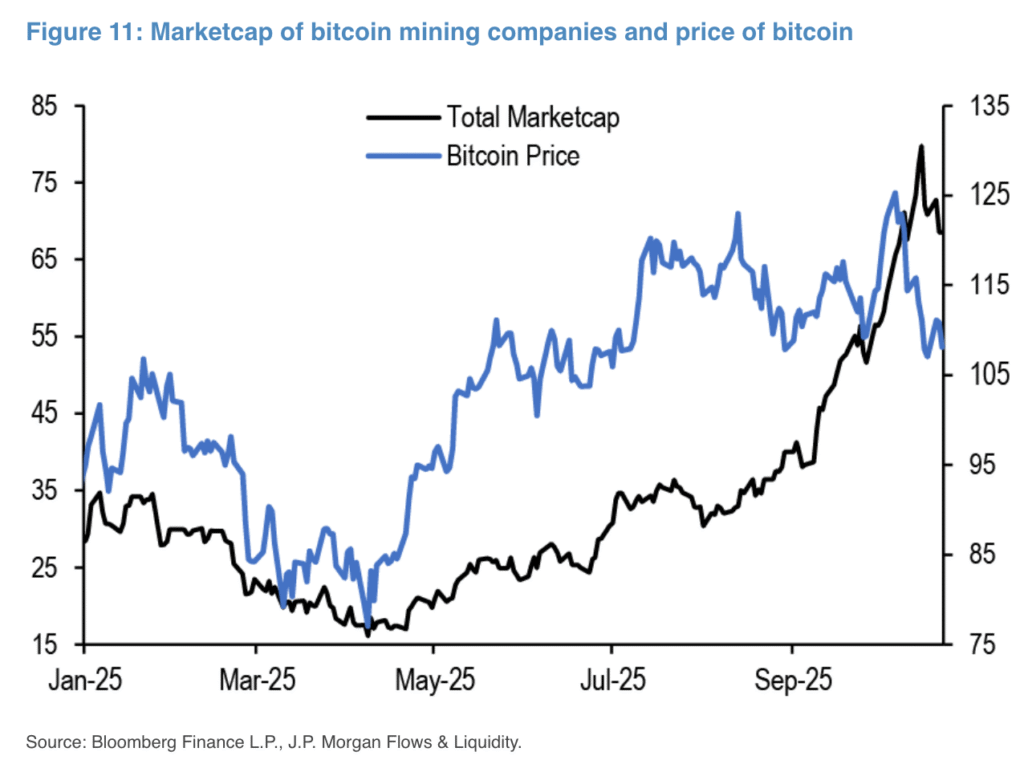Title: The Evolution of Bitcoin Mining Firms: A Shift Towards AI and Its Implications
In recent months, a notable divergence has emerged between publicly listed Bitcoin mining firms and the price performance of Bitcoin itself. According to analysts from JPMorgan, the combined market capitalization of these mining firms has experienced significant growth since July, while Bitcoin’s price has largely remained stable. This shift represents a "clear breakdown" in the correlation that once existed between Bitcoin mining stocks and the cryptocurrency’s market movements. Previously viewed as proxies for Bitcoin investments, mining stocks are now increasingly influenced by their ventures into artificial intelligence (AI), marking a pivotal change in how these firms are perceived in the financial landscape.
Historically, Bitcoin mining stocks closely mirrored Bitcoin’s price movements; however, the introduction of spot Bitcoin exchange-traded funds (ETFs) has altered this dynamic. The report, led by JPMorgan’s managing director Nikolaos Panigirtzoglou, highlights how many major Bitcoin miners are pivoting their business strategies to capitalize on the burgeoning AI sector. This transition allows them to pursue more stable and higher-margin revenue streams, which have become critical amid the increasing volatility and declining profitability in the traditional Bitcoin mining sector.
The move towards AI is particularly timely given the pressures facing Bitcoin miners due to the upcoming April 2024 Bitcoin halving event. This event is set to halve the block rewards from 6.25 BTC to 3.125 BTC, which will significantly impact miners’ profitability. JPMorgan analysts project that the current average cost to mine a single Bitcoin is around $92,000, a figure that could escalate to approximately $180,000 after the next halving in April 2028. Such rising costs, driven by higher energy prices and increased hardware expenses, together with the challenges of power contract renewals, pose risks for miners’ economic viability.
As miners increasingly allocate resources to AI computing, the overall growth of Bitcoin’s network hashrate may decelerate, potentially limiting any further increases in production costs. This trend appears to favor larger, well-capitalized mining firms that can adeptly transition their capacity between Bitcoin and AI operations. Conversely, smaller firms might struggle to adapt to the changing market conditions, leading some to explore alternative opportunities, such as establishing treasuries in Ethereum and Solana.
Furthermore, the current environment demands that mining companies not only diversify their business models but also innovate in their operational approaches. With the anticipated challenges of Bitcoin mining profitability, miners’ focus on AI technologies may unlock new sources of revenue and diversification. This strategy enables them to remain competitive in a rapidly evolving market landscape, where adaptability and foresight are critical to sustaining growth.
In conclusion, the divergence of Bitcoin mining firms from Bitcoin’s price trends signifies a transformative moment in the industry. By pivoting towards AI, these companies are positioning themselves for not only higher revenues but also enhanced stability amidst the uncertain future of Bitcoin mining. As the industry continues to evolve, it will be vital for miners to remain agile and responsive to market dynamics, fostering innovation that aligns with emerging technological trends. Investors and stakeholders should closely monitor these developments, as they could shape the future trajectory of both mining companies and the broader cryptocurrency market.


